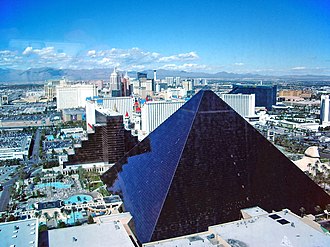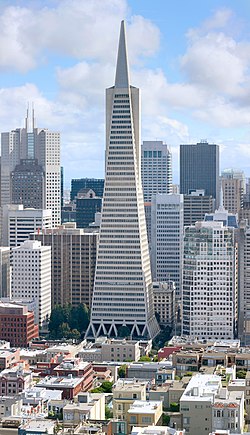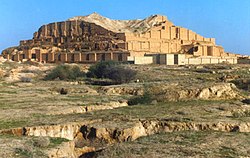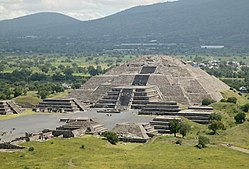Pyramid
A pyramid is a structure, usually made of stone, built in the shape of a pyramid. From ancient to modern times people in many different parts of the world have built such structures.
The word "pyramid" comes from the Greek word pyramis which meant "wheat cake." The ancient Egyptian word for them was something like "Mer".[1] The Great Pyramid of Giza was one of the Seven Wonders of the ancient world.
The first pyramids were built in 2630 B.C. The oldest known pyramid was made for king Djoser of the third Dynasty.
Egyptian pyramids
In Egypt, kings and queens, called Pharaohs, were buried in the tombs of huge square-bottomed pyramids built of stone. They were usually built to be used as tombs for Pharaohs. The ancient Egyptian pyramids are very well built. Some of the pyramids still stand today.[2]
The oldest man-made pyramid found is called the Step pyramid. It is in the Giza Necropolis in Saqqara, near Cairo, Egypt. It was built for King Djoser thousands of years ago. Later pyramids were built much larger. The largest one was the Great Pyramid of Giza. It is near Cairo. It was the tallest building in the world until the Eiffel Tower was built in Paris, in 1889. The Great Pyramid was built by the pharaoh Khufu (= Cheops) from the Ancient Egyptian Old Kingdom. Herodotus was told by his Egyptian guides that it took twenty years for a force of 100,000 slaves to build the pyramid (with another ten years to build a stone causeway that connected to a temple in the valley below).
People once thought pyramids were built by slaves. More recent evidence suggests that the workers who built the pyramids were paid and well-cared for. They were loyal to the Pharaoh. Inside the Great Pyramid, famous man-made objects have been found from ancient times. Many valuable items were buried with the dead Pharaohs, in the hope that they would take them to the afterlife. Pyramids usually had traps to stop thieves from escaping easily. Tomb thieves were punished by death if they were caught. However, by 1000 BC, many of the pyramids had been robbed of their precious treasures.
A large statue of a Sphinx stands near the pyramids at Giza. It has the body of a Lion and the head of a Pharaoh.
The ancient Greeks called the Great Pyramid one of the seven wonders of the world. There are over 100 pyramids in Egypt. Most of them are on the western side of the River Nile. Some Egyptologists have different opinions on why the ancient Egyptian Kings built pyramids as their tombs. Pyramids have been excavated for about the last 200 years.
The ancient Egyptians believed that the Egyptian pharaohs went to the stars to join their gods in the afterlife.
Pyramids in the Americas
The Aztecs and Mayans also built many massive pyramids. None are as old or big as the oldest or biggest Egyptian pyramids. Most of them are step pyramids.
Unlike Egyptian pyramids, which were used as tombs for rulers and wealthy people, Aztec and Mayan pyramids are believed to have been used for public displays of human sacrifice.
Modern pyramids
- The Louvre Pyramid in Paris, France, in the court of the Louvre Museum. It is a 20.6 meter (about 70 foot) glass structure which acts as an entrance to the museum. It was designed by the American architect I. M. Pei and completed in 1989.
- The Luxor Hotel in Las Vegas, United States, is a 30-story true pyramid. It has light beaming from the top.
- The 32-story Pyramid Arena in Memphis, Tennessee (a city named after the ancient Egyptian capital whose name itself was derived from the name of one of its pyramids). Built in 1991, it was the home court for the University of Memphis men's basketball program and the National Basketball Association's Memphis Grizzlies until 2004.
- The Walter Pyramid is home to the basketball and volleyball teams of the California State University, Long Beach, campus in California, United States. It is an 18-story-tall blue true pyramid.
- The 48-story Transamerica Pyramid is in San Francisco, California It was designed by William Pereira. The pyramid is one of the city's symbols.
- The 105-story Ryugyong Hotel is in Pyongyang, Northern Korea.
- "Pyramid of Tirana" is a former museum and monument in Tirana, Albania.
- The Slovak Radio Building is in Bratislava, Slovakia. This building is shaped like an inverted pyramid.
- The Summum Pyramid is a three-story pyramid in Salt Lake City, Utah. It used for instruction in the Summum philosophy. it also conducts rites associated with Modern Mummification.
- The Palace of Peace and Reconciliation is in Nur-Sultan, Kazakhstan.
- The Pyramids at Osho Commune are in Pune, India. They are used for meditation purposes.
- The three pyramids of Moody Gardens in Galveston, Texas.
- The Co-Op Bank Pyramid or Stockport Pyramid is in Stockport, England. is a large pyramid shaped office building in Stockport in England.
- The Ames Monument is in southeastern Wyoming. It honors the brothers who financed the Union Pacific Railroad.
- The Trylonis a triangular pyramid erected for the 1939 World's Fair in Flushing, Queens. It was demolished after the Fair closed.
- The Ballandean Pyramid is in Ballandean in rural Queensland, Australia. It is a 15-meter folly pyramid made from blocks of local granite.
- The Karlsruhe Pyramid is in the centre of the market square of Karlsruhe, Germany. It is made of red sandstone. It is in the centre of the market square of Karlsruhe, Germany. It was erected in the years 1823–1825.
- The GoJa Music Hall is in Prague.
- The Muttart Conservatory greenhouses are in Edmonton, Alberta.
- Small pyramids similar to those of the Louvre can be found outside the lobby of the Citicorp Building in Long Island City, Queens NY.
- The Pyramids of the City Stars Complex is in Cairo, Egypt.
- Pyramid building belonging to The Digital Group (TDG), at Hinjwadi, Pune, India.[3]
- The Steelcase Corporate Development Center near Grand Rapids, Michigan.
- Sunway Pyramid shopping mall in Selangor, Malaysia.
- Hanoi Museum with an overall design of a reversed Pyramid.
- The Pyramide des Ha! Ha! by artist Jean-Jules Soucy fr:Jean-Jules Soucy in La Baie, Quebec is made out of 3 000 give way signs.[4]
- The "Pyramid" culture-entertainment complex and Monument of Kazan siege (Church of Image of Edessa) are in Kazan, Russia.
- The "Phorum" of Expocentre business-exhibition complex is in Moscow, Russia.
- Few pyramids of the Marco-city shopping-entertainment complex are in Vitebsk, Belarus.[5]
- The Time pyramid is in Wemding, Germany. The pyramid begun in 1993. It is scheduled for completion in the year 3183.[6]
- Triangle is a proposed skyscraper in Paris.
- The Shimizu Mega-City Pyramid, a proposed project for construction of a massive pyramid over Tokyo Bay in Japan.
- The tomb of Quintino Sella, outside the monumental cemetery of Oropa.[7]
- The unbuilt Museum of Modern Art of Caracas was designed as an upside down pyramid. Playing on a variation of the famous configuration Oscar Niemeyer inverted the geometry of the pyramid.[8]
Other pyramids
There are also ancient pyramids in other parts of Africa, Central America, Europe, North America, and Asia. There is a famous modern glass pyramid in front of the Louvre Museum in Paris. The Luxor Hotel, in Las Vegas, Nevada is also a glass pyramid.
Pyramid Media
Pyramid of Khafre, Egypt, built c. 2600 BC
Prasat Thom temple at Koh Ker, Cambodia
Chogha Zanbil is an ancient Elamite complex in the Khuzestan province of Iran.
The pyramids of the Giza necropolis, as seen from the air
Pyramids of Güímar, Tenerife, Spain
Pyramid of Cestius in Rome, Italy
Pyramid of the Moon, Teotihuacan, built between 100 and 450 AD
Related pages
References
- ↑ Janet, Wood. "ANCIENT NILE'S ANCIENT EGYPT: PYRAMIDS History of the Egyptian Pyramids". 1995. Ancientnile.co.uk. Retrieved 11 November 2014.
- ↑ "Ancient Egyptian History for Kids: Pyramids". www.ducksters.com.
- ↑ "Information Technology Services, Solutions | IT Consulting & IT Managed Services - The Digital Group". www.thedigitalgroup.com.
- ↑ "La pyramide de la baies des HaHa".
- ↑ В Витебске открыли пирамиду «Марко-сити» Archived 2014-05-17 at the Wayback Machine accessed: 13 November 2014
В Витебске прошло открытие торгово-развлекательного комплекса «Марко-сити» Archived 2012-07-10 at the Wayback Machine - ↑ Conception Official Zeitpyramide website, accessed: 13 November 2014
- ↑ Luisa Bocchietto, Mario Coda and Carlo Gavazzi. "THE OTHER OROPA: A Guide to the Monumental Cemetery of the Sanctuary" (PDF). Archived from the original (PDF) on 2014-05-17. Retrieved 2014-11-12.
- ↑ http://www.vitruvius.com.br/revistas/read/arquitextos/13.151/4465 |accessed: 13 November 2014
Other websites
| Wikimedia Commons has media related to Lua error in Module:Commons_link at line 62: attempt to index field 'wikibase' (a nil value).. |
- EGYPT - CAIRO AND THE PYRAMIDS Archived 2014-10-26 at the Wayback Machine
- Mayan Ruins
- Famous landmarks of Egypt Archived 2020-12-16 at the Wayback Machine
















